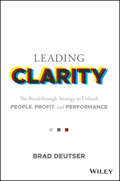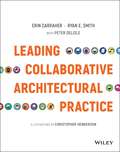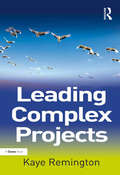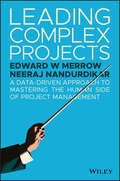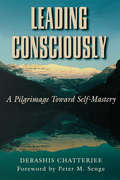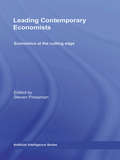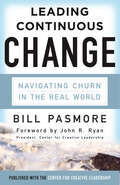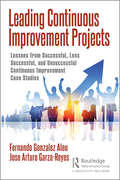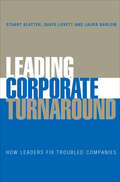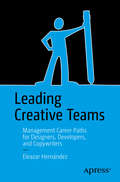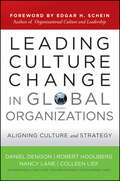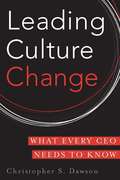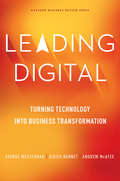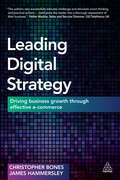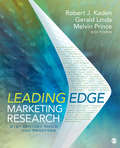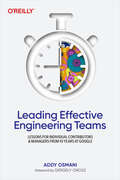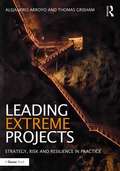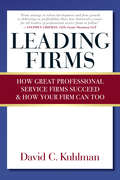- Table View
- List View
Leading Citigroup (B)
by Carin-Isabel Knoop Aldo Sesia Lynn Sharp PaineThe (B) case describes the actions taken by Citigroup CEO Chuck Prince and his management team to right the company in the wake of the controversies and alleged misdeeds described in the (A) case.
Leading Clarity: The Breakthrough Strategy to Unleash People, Profit and Performance
by Brad DeutserMore powerful than strategy, culture, or innovation, discover the one business tool that is the ultimate game-changer! Leading Clarity offers a bold proposal that changes the trajectory of your business and leadership. Today’s business environment is more complex than at any time in history with greater ambiguity, chaos and uncertainty. Too often, individuals and organizations become bogged down with competing priorities and the constant press of daily demands. This tangled mass of noise effectively handicaps every facet of business. This book provides a proven, time-tested strategy that has brought dynamic results to hundreds of organizations of all scope and size. Informed by in-depth research conducted by the Deutser team, made up of business strategists, social scientists, organizational psychologists, innovation specialists and designers, the framework and methodologies presented will align focus and drive organizational performance. Leading Clarity takes you beyond understanding the strengths and weaknesses of individuals and teams, and guides you through a dynamic process that unveils what is most critical and most enduring about your business. Clarity is the key measure of unprecedented success and a vital factor in productivity, engagement, and performance. Now, Deutser is sharing the secrets of his proven blueprint for creating clarity. With these powerful principles and stories of how to put them to work, you too can leverage the exponential impact of clarity.
Leading Collaborative Architectural Practice: Techniques From The Forefront
by Ryan E. Smith Erin CarraherThe groundbreaking guide to modern leadership in architectural practice Leading Collaborative Architectural Practice is the leadership handbook for today's design and construction professionals. Endorsed by the American Institute of Architects, this book describes the collaborative approach to leadership that is becoming increasingly prevalent in modern practice; gone are the days of authoritative "star" architects— today's practice is a brand, and requires the full input of every member of the team. This book builds off of a two-year AIA research project to provide a blueprint for effective leadership: the ability, awareness, and commitment to lead project teams who work together to accomplish the project's goals. Both group and individual hands-on exercises help facilitate implementation, and extensive case studies show how these techniques have helped real-world firms build exemplary success through collaborative teamwork and leadership. Highly illustrated and accessible, this approach is presented from the practicing architect's point of view—but the universal principles and time-tested methods also provide clear guidance for owners, contractors, engineers, project managers, and students. Build a culture of collaboration, commitment, and interpersonal awareness Adopt effective leadership techniques at the team, project, or practice level Handle conflict and resolve communication issues using tested approaches Learn how real-world projects use effective leadership to drive success The last decade has seen a sea-change in architectural leadership. New practices no longer adopt the name and identity of a single person, but create their own identity that represents the collaborative work of the entire group. Shifts in technology and changing workplace norms have made top-down management structures irrelevant, so what does it now mean to lead? Forefront presents effective contemporary leadership in the architectural practice, and real-world guidance on everyday implementation.
Leading Complex Projects
by Kaye RemingtonLeadership in projects has been under-represented in many of the most influential project methodologies, where the focus has been on management and process. The importance to project success of key roles such as project board member, executive sponsor, project manager, client representative or team leader, increases exponentially with the scale and complexity of the project. Kaye Remington's Leading Complex Projects draws on original, empirical research into successful leadership of complex projects, including 70 in-depth interviews with people, across a broad range of industries, selected for their roles in guiding complex projects towards successful outcomes. The book, structured around the major themes from the interviews, explains and applies emerging best-practice in a coherent and focused way. A potent combination of wisdom from leaders in practice and the latest knowledge from many fields of research will engage experienced practitioners, as well as those who are teaching and researching projects, complexity and leadership.
Leading Complex Projects: A Data-Driven Approach to Mastering the Human Side of Project Management
by Edward W. MerrowQuantitative analysis of outcomes vs PMs at the individual level Leading Complex Projects takes a unique approach to post-mortem analysis to provide project managers with invaluable insight. For the first time, individual PM characteristics are quantitatively linked to project outcomes through a major study investigating the role of project leadership in the success and failure of complex industrial projects; hard data on the backgrounds, education, and personality characteristics of over 100 directors of complex projects is analyzed against the backdrop of project performance to provide insight into controllable determinants of outcomes. By placing these analyses alongside their own data, PMs will gain greater insight into areas of weakness and strength, locate recurring obstacles, and identify project components in need of greater planning, oversight, or control. The role of leadership is to deliver results; in project management, this means taking responsibility for project outcomes. PMs are driven by continuous improvement, and this book provides a wealth of insight to help you achieve the next step forward. Understand why small, simple projects consistently outperform larger, more complex projects Delve into the project manager's role in generating successful outcomes Examine the data from over 100 PMs of complex industrial projects Link PM characteristics to project outcome to find areas for improvement Complex industrial projects from around the world provide a solid basis for quantitative analysis of outcomes—and the PMs who drive them. Although the majority of the data is taken from projects in the petroleum industry, the insights gleaned from analysis are widely applicable across industry lines for PMs who lead complex projects of any stripe. Leading Complex Projects provides clear, data-backed improvement guidance for anyone in a project management role.
Leading Consciously
by Peter Senge Debashis ChatterjeeLeading Consciously addresses the issues of motivation, decision-making, communication, time management, effective learning, work psychology, organizational development, and self-mastery. The author weaves together the insights of some of the most remarkable leaders of the world whose lives embody great truths about leadership and self-transformation, masters such as M. K. Gandhi, Edmund Hillary, Mother Teresa, and Albert Einstein.Debashis Chatterjee is an international management thinker, Fulbright scholar, corporate philosopher, mystic, and writer. He is a member of the faculty in Behavioral Sciences at the Indian Institute of Management in Lucknow, India. An immensely popular speaker on the themes of spirituality and modern management, Chatterjee organizes frequent leadership retreats for diverse audiences of executives, doctors, scientists, political leaders, and social service workers in India and around the world.
Leading Contemporary Economists: Economics at the cutting edge (Routledge Studies In The History Of Economics Ser. #Vol. 95)
by Steven PressmanThis book describes the important contributions of several contemporary economic figures including recent Nobel Laureates. Describing their work and putting it into an historical perspective, these chapters explain how their work constitutes a major contribution to the discipline of economics and how it has broadened economic science. Co-Editor of
Leading Contemporary Organizations: Psychodynamic Perspectives on Crisis and Change
by Amy L. FraherWhy do organizations fail? What hinders otherwise responsible leaders from recognizing looming disasters? What prevents well-intentioned people from responding properly to an emerging crisis? Using systems psychodynamics to analyze an array of international crises, Amy L. Fraher explores ethical challenges at Silicon Valley tech companies, the Wall Street implosions that led to the 2008 financial industry crash, and a wide range of social crises, policy failures, and natural disasters, offering a crisis management philosophy applicable in diverse settings. Rather than viewing crises as anomalies that cannot be anticipated, Fraher persuasively argues that crises can, and should, be embraced as naturally occurring by-products of any organization's change management processes. If leaders do not proactively manage organizational change, they will inevitably manage crisis instead. This accessible textbook will appeal to business students and researchers studying leadership, change and crisis, as well as progressive-minded business leaders keen to improve their own organizations.
Leading Continuous Change: Navigating Churn in the Real World
by Bill PasmoreMost change efforts fail because most change methods are built to deal with single challenges in a nice, neat, linear way. But leaders know that today, pressures for change don't come at you one at a time; they come all at once. It's like riding a roller coaster: sudden drops, jarring turns, anxious climbs into the unknown. Drawing on his years of experience at the Center for Creative Leadership and Columbia University, Bill Pasmore offers a four-part model and four mindsets that allow leaders to deal with multiple changes simultaneously without drowning in the churn. The first step, Pasmore says, is to Discover which external pressures for change are the most necessary to address. The key here is to think fewer-step away from the buffet of possibilities and pinpoint the highest-impact options. Then you need to Decide how many change efforts your organization can handle. Here the mindset is to think scarcer-you have only so many people and so many resources, so how do you best use them? Once you've figured that out, it's time to Do-and here you want to think faster. Streamline processes and engage in rapid prototyping so you can learn quickly and cost-effectively. The last step is to Discern what worked and what didn't, so think smarter-develop metrics, identify trends, and make sure learnings are disseminated throughout the organization.For each stage of the process, Pasmore offers detailed advice, practical tools, and real-world examples. This book is a comprehensive guide to navigating change the way it happens now.
Leading Continuous Improvement Projects: Lessons from Successful, Less Successful, and Unsuccessful Continuous Improvement Case Studies
by Jose Arturo Garza-Reyes Fernando Gonzalez AleuThis book is a reference for continuous improvement project (CIP) leaders/facilitators in manufacturing and service organizations, students (undergraduate and graduate), academics responsible for managing senior projects (Capstone Projects) and teaching quality courses, and researchers interested in how organizations could produce more effective and efficient continuous improvement initiatives and projects. The authors collected and analyzed information and results from CIPs they facilitated or co-advised, such as the improvement of the service level in a bottle manufacturing organization, reduction of changeover in a brewery manufacturing organization, reduction of ambulance response time, and reduction of scrap in a steel transformation manufacturing organization. Many of the CIPs were previously part of award-winning white papers documenting critical improvements. Throughout this book, readers will learn: different types of CIPs metrics to identify successful CIPs the 53 factors related to CIPs success how to manage CIPs behaviors to achieve outstanding results from CIPs. Three of the chapters are supplemented with three or more case studies. In addition, the final chapter includes a list of behaviors expected from directors, continuous improvement managers, CIP leaders/facilitators, and CIP team members to obtain the major benefits from CIPs.
Leading Corporate Turnaround: How Leaders Fix Troubled Companies
by David Lovett Stuart Slatter Laura BarlowLeadership is never more crucial than when corporate survival is at stake. But the days of the tough guys are over. The leaders who are driving todays sustainable turnarounds understand that the answers to a distressed companys problems lie almost always within the firm itself usually at middle manager level and below. The secret is cooperation. Drawing on interviews with top company doctors and advisers, as well as on the authors own experience, Leading Corporate Turnarounds explores seven key leadership and management skills required for successful turnaround, and shows why quickly gaining the buy-in and trust of all stakeholders is the key to ultimate success. Written by the founding directors of the Society of Turnaround Professionals (STP), with a proposed Foreword by the Societys Patron Sir John Harvey-Jones Considers the different drivers of turnaround, the alternatives to it, and the restructuring processes required to move beyond crisis stabilization to sustainable change Features international case studies from leading companies including BT, Virgin Express, Arthur Andersen, Parmalat, GE, Lee Cooper, New Look and IBM
Leading Creative Teams
by Eleazar HernándezLearn the skills you must master to assume leadership roles—creative directors, art directors, and advertising managers—on creative teams and in integrated branding campaigns for corporate clients. This book compares and contrasts the skill sets and responsibilities of creatives with those of managers who direct creative teams. Technical competence in the creative arts is a necessary but not sufficient prerequisite for promotion to and success in positions directing creative teams. Business, management, and communication skills are equally necessary. Leading Creative Teams reviews the business metrics that the manager of a creative team must be able to manipulate and present persuasively to the organization to prove that the team’s creative excellence delivers superior ROI. Award-winning designer and veteran creative director Eleazar Hernández walks you through the creative manager’s skill sets—technical, business, management, and communication. He covers the techniques and tools common to the direction of creative teams in all industries: brainstorming, creative exploration and visual communication tools, internal and client presentations, critiquing, mentoring, and copywriting. Hernández shows how creative directors can apply management and leadership skill sets to different kinds of creative teams found across interactive, graphic design and advertising industries and how they orchestrate methods among team members. He details how creative teams vary in their concepts and principles, composition, objectives, and processes according to their specific industries and project requirements. And he shows you how to shape your career trajectories toward creative management roles in your chosen field.Leading Creative Teams features information on the processes and best practices for ideating, developing, and directing advertising campaigns, graphic design projects, :30 TV spot and :30 radio spots. Drawing on interviews with top creative directors, art directors, and advertising managers, the author explores how the roles of creative team managers are evolving in response to changing technologies and business models.What You'll LearnLearn the technical, business, and management skill sets of creative managementLead and orchestrate teams of creativesDiscover tips, tricks, and techniques for creative direction of web, broadcast, and print projectsShape your career trajectory toward creative managementLearn the dos and don’ts of creative presentationsWho This Book Is ForMid-level and junior creatives—graphic designers, web designers, copywriters, and artists—and ad students who seek information on the specific skills, experience, and credentials they need to qualify for promotion to creative management. The secondary readership is creative directors, art directors, and advertising managers who lead web interactive, design, and advertising creative teams and who develop and direct integrated branding campaigns for corporate clients.
Leading Cultural Change
by David Potter James MccalmanWith coverage of the major theories and concepts alongside diagnostic tools and a practical framework for implementation, Leading Cultural Change will help the reader analyse and diagnose their current organizational culture, become aware of the key challenges and how to overcome them and learn how to adapt their leadership style, ensuring they are fit to lead a cultural change programme. Taking in core topics such as change context, language and dialogue as a key cultural process and the change team process, it uses a longitudinal case study of Cordia, a public sector organization transitioning into an LLP, to enhance learning and understanding. Leading Cultural Change is a unique text, rooted in behavioural sciences, which explores the topic as an organizational necessity to achieving sustained competitive advantage.
Leading Culture Change at SEB
by Amy C. Edmondson Elena CorsiThe Risk organization at SEB, a leading Nordic financial services group founded in 1856, undertook a culture change program focused on psychological safety, empathic listening, and strategic framing. The program enabled risk organization teams to make progress on strategic challenges and improved decision making processes. Chief Risk Officer Magnus Agustsson believed that the rest of SEB should go through a similar program. But it was not clear how to convince other departments to invest considerable time in developing the soft skills of culture change.
Leading Culture Change in Global Organizations
by Daniel Denison Colleen Lief Nancy Lane Robert HooijbergFilled with case studies from firms such as GT Automotive, GE Healthcare China, Vale, Dominos, Swiss Re Americas Division, and Polar Bank, among others, this book (written by Dan Denison and his co-authors) combines twenty years of research and survey results to illustrate a critical set of cultural dynamics that firms need to manage in order to remain competitive. Each chapter uses a case as a means to illustrate an important aspect of culture change focusing on seven common culture-change dilemmas including creating a strategic alignment, keeping strategy simple, and more.
Leading Digital
by George Westerman Andrew Mcafee Didier BonnetLeading Digital makes the provocative argument that the next imminent phase of digital technology adoption - driven by the convergence of mobility, analytics, social media, cloud computing, and embedded devices - will make everything that's happened so far look like a prelude. The authors, a trio of highly regarded thought leaders on corporate digital transformation, say changes in the digital realm so far have focused on high tech and media companies - but there's still a whopping 94% of the business economy that needs to change. This book will show them how.George Westerman of MIT, Didier Bonnet of Capgemini Consulting, and Andrew McAfee, also at MIT, say there is opportunity for these businesses to learn from those that have already mastered the digital landscape. Based on a study of more than 400 large, mainstream firms in every industry around the globe, the authors usefully break down how these organizations have used their own digital transformation to gain strategic, competitive advantage. Readers will learn how these digital leaders have transformed their businesses through smart and rigorous digital investments, and through smart and effective leadership of the change.Leading Digital offers practical, real-life tested frameworks that can be instantly applied. Case studies include Nike, Caesars, Burberry, Asian Paints, Pages Jaunes, Codelco, and more.
Leading Digital Strategy
by Christopher Bones James HammersleyFor a business to thrive competitively in today's marketplace, it needs to have an effective e-commerce channel. Getting it right opens up new markets and opportunities; getting it wrong leads to declining revenues and profitability. To ensure effectiveness, business leaders and decision-makers must understand how e-commerce channels work to make the best strategic choices for their business. Drawing on experience in consulting to large complex organisations and ground-breaking primary research with senior executives from leading corporations, Leading Digital Strategy creates a convincing case for action and offers practical strategies, methodologies and models to improve the effectiveness of a company's online offering. It explores how to align organizational structure with wider goals and implement a customer-centric culture. With coverage of the key digital trends, tools and technologies affecting business today, it provides a practical framework for multi-channel success. This book challenges leaders to become as fluent and creative in digital as they are in finance, sales and marketing, and equips them to choose the right strategy and the right people to make it happen. With strategies for improved operational performance and enhanced engagement from senior management, Leading Digital Strategy gives readers the power to drive forward effective digital initiatives and realize rewarding opportunities for change.
Leading Digital: Turning Technology into Business Transformation
by George Westerman Andrew Mcafee Didier BonnetLeading Digital makes the provocative argument that the next imminent phase of digital technology adoption - driven by the convergence of mobility, analytics, social media, cloud computing, and embedded devices - will make everything that’s happened so far look like a prelude. The authors, a trio of highly regarded thought leaders on corporate digital transformation, say changes in the digital realm so far have focused on high tech and media companies - but there’s still a whopping 94% of the business economy that needs to change. This book will show them how. George Westerman of MIT, Didier Bonnet of Capgemini Consulting, and Andrew McAfee, also at MIT, say there is opportunity for these businesses to learn from those that have already mastered the digital landscape. Based on a study of more than 400 large, mainstream firms in every industry around the globe, the authors usefully break down how these organizations have used their own digital transformation to gain strategic, competitive advantage. Readers will learn how these digital leaders have transformed their businesses through smart and rigorous digital investments, and through smart and effective leadership of the change. Leading Digital offers practical, real-life tested frameworks that can be instantly applied. Case studies include Nike, Caesars, Burberry, Asian Paints, Pages Jaunes, Codelco, and more.
Leading Edge Marketing Research: 21st-Century Tools and Practices
by Robert J. Kaden Gerald L. Linda Dr Melvin PrinceThis book explores new and leading edge marketing research approaches as successfully practiced by visionaries of academia and the research industry. Ideal as either a supplementary text for students or as a guidebook for practitioners, this book showcases the excitement of a field where discoveries abound and researchers are valued for solving weighty problems and minimizing risks. The authors offer rich new tools to measure and analyze consumer attitudes, combined with existing databases, online bulletin boards, social media, neuroscience, radio frequency identification (RFID) tags, behavioral economics, and more. The reader will profit from the numerous contemporary case studies that demonstrate the key role of marketing research in corporate decision-making.
Leading Edge Technologies in Fashion Innovation: Product Design and Development Process from Materials to the End Products to Consumers (Palgrave Studies in Practice: Global Fashion Brand Management)
by Young-A LeeThis book offers cutting-edge knowledge on various design and product development related technologies, and applications of these technologies in fashion. Further, it envisions the future of these technologies when designing and engineering apparel-related products. Demonstrating how theory turns into practice, this volume presents the analysis of cases representing a successful collaboration between innovative technology and fashion. These current examples of industry and consumer cases with the use of various technologies will allow readers to fully connect how the industry currently implements these technologies into product design and development process as well as communicating with consumers. This text will serve as a valuable resource to researchers and educators in the fields of supply chain management, branding, marketing, fashion studies, textiles, and product design.
Leading Effective Engineering Teams: Lessons for Individual Contributors and Managers from 10 Years at Google
by Addy OsmaniIn this insightful and comprehensive guide, Addy Osmani shares more than a decade of experience working on the Chrome team at Google, uncovering secrets to engineering effectiveness, efficiency, and team success. Engineers and engineering leaders looking to scale their effectiveness and drive transformative results within their teams and organizations will learn the essential principles, tips, and frameworks for building highly effective engineering teams.Osmani presents best practices and proven strategies that foster engineering excellence in organizations of all sizes. Through practical advice and real-world examples, Leading Effective Engineering Teams empowers you to create a thriving engineering culture where individuals and teams can excel. Unlock the full potential of your engineering team and achieve unparalleled success by harnessing the power of trust, commitment, and accountability.With this book, you'll discover:The essential traits for engineering effectiveness and the pitfalls to avoidHow to cultivate trust, commitment, and accountability within your teamStrategies to minimize friction, optimize career growth, and deliver maximum valueThe dynamics of highly successful engineering teams and how to replicate their achievementsHow to implement a systems thinking approach for everyday problem-solving and decision-makingSelf-advocacy techniques to enhance your team's visibility and recognition within the organization
Leading Extreme Projects: Strategy, Risk and Resilience in Practice
by Alejandro Arroyo Thomas GrishamLeading Extreme Projects explores the challenges, obstacles and techniques associated with running large projects in some of the most challenging environments and economies in the world. From an oil and gas program in the Amazon with a background of drug trafficking, delicate indigenous communities and some of the most challenging logistics; to a mining project in West Africa involving a consortium of state and private contractors plus a global supply chain. From a shipping efficiency project involving two joint venture programs with stakeholders from the European, North and South American and Asian continents; to a hostile gold project stakeholder management process in Central America involving substantial cultural differences between the north and the south. The authors’ insights and advice will help the reader understand the global context of leadership in these extreme projects as well as the nature of the structures and teams required to create, design, operate and transfer global capital programs. In particular, they provide perspectives on the issues of leading cross-cultural teams, working amongst sensitive indigenous people and transferring knowledge to build local capacity. This is an important reference text for senior executives involved in both the strategy and the delivery side of extreme projects, as well as for those researching and studying the field.
Leading Firms
by David KuhlmanLeading a professional service firm is difficult enough in good times, and it is all the more risky in difficult ones. In Leading Firms: How Great Professional Service Firms Succeed & How Your Firm Can Too David Kuhlman, a highly respected management consultant to many of the world's top firms, gives an informed view on how those in professional services can achieve the same success as best-in-class firms. Most businesses claim that people are their most important asset, but Kuhlman explains that professional service firms are unique because their entire value chain consists of people who must differentiate themselves from competitors who often offer the same product in similar ways with near-identical messaging. From the author's examination of why it's more difficult to implement change than in a traditional business, to his analysis of the challenges of rising above the competition, he offers a comprehensive guide to the special dynamics of the professional services firm. Kuhlman covers in striking detail the aspects of the daily dealing with clients and markets as well as the planning and implementation of long-term strategy that leading a firm requires. This book is divided into three parts. The first lays out foundations of success for any firm; this includes developing an effective strategy and also delivering consistent revenue, maintaining quality and maintaining profitability. The second section puts a strong focus on the capabilities that great firms possess as opposed to firms that are just merely "good. " This includes managing talent, delivering growth, and establishing brand synergy. The last part is about the practices and values necessary to develop a high-performing culture of professionals, one that continually nourishes the growth of superior talent while successfully managing client relationships and expectations. Leading Firms is perfect for anyone who wants to explore their firm's potential and to better understand how the most successful firms in their industry arrived at their positions of leadership. It serves as a how-to guide for anyone leading in, or participating in, moving a professional service firm forward.

